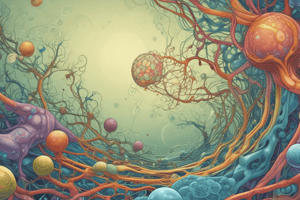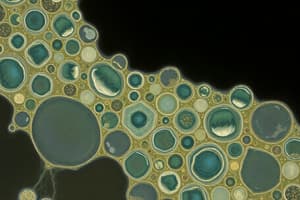Podcast
Questions and Answers
What does the Cell Theory state?
What does the Cell Theory state?
- Living organisms can be made of organelles.
- All cells arise spontaneously.
- The cell is the basic unit of life. (correct)
- Only eukaryotic cells have a nucleus.
Which type of cell is characterized by the absence of a true nucleus?
Which type of cell is characterized by the absence of a true nucleus?
- Eukaryotic cells
- Animal cells
- Prokaryotic cells (correct)
- Plant cells
What is the primary function of the mitochondria?
What is the primary function of the mitochondria?
- ATP production (correct)
- Protein synthesis
- Waste breakdown
- Lipid synthesis
Which organelle is responsible for modifying and packaging proteins?
Which organelle is responsible for modifying and packaging proteins?
What is the name of the process that results in two identical daughter cells?
What is the name of the process that results in two identical daughter cells?
Which type of Endoplasmic Reticulum is involved in synthesizing lipids?
Which type of Endoplasmic Reticulum is involved in synthesizing lipids?
How do signaling molecules primarily act on cells?
How do signaling molecules primarily act on cells?
What is the function of lysosomes in a cell?
What is the function of lysosomes in a cell?
Flashcards are hidden until you start studying
Study Notes
Cell Biology Study Notes
Basic Concepts
-
Cell Theory:
- All living organisms are composed of cells.
- The cell is the basic unit of life.
- All cells arise from pre-existing cells.
-
Types of Cells:
- Prokaryotic Cells: Lack a true nucleus and membrane-bound organelles; examples include bacteria and archaea.
- Eukaryotic Cells: Have a true nucleus and organelles; examples include plant cells, animal cells, fungi, and protists.
Cell Structure
-
Cell Membrane:
- Composed of a phospholipid bilayer with embedded proteins; semi-permeable.
- Functions in transport, signaling, and maintaining homeostasis.
-
Nucleus:
- Control center of the cell; contains DNA.
- Surrounded by a nuclear envelope with nuclear pores for material exchange.
-
Cytoplasm:
- Gel-like substance within the cell membrane; site of metabolic processes.
- Contains organelles suspended in the cytosol.
-
Organelles:
- Mitochondria: Powerhouse of the cell; site of ATP production via cellular respiration.
- Ribosomes: Sites of protein synthesis; can be free in the cytoplasm or attached to the endoplasmic reticulum.
- Endoplasmic Reticulum (ER):
- Rough ER: Studded with ribosomes; synthesizes proteins.
- Smooth ER: Lacks ribosomes; synthesizes lipids and detoxifies drugs.
- Golgi Apparatus: Modifies, sorts, and packages proteins and lipids for secretion or use within the cell.
- Lysosomes: Contain digestive enzymes for breaking down waste materials and cellular debris.
- Peroxisomes: Contain enzymes that produce and degrade hydrogen peroxide; involved in lipid metabolism.
-
Cytoskeleton:
- Network of protein fibers providing structural support, cell shape, and movement; includes microfilaments, intermediate filaments, and microtubules.
Cell Division
- Mitosis: Process of cell division resulting in two identical daughter cells; includes stages:
- Prophase
- Metaphase
- Anaphase
- Telophase
- Meiosis: Specialized cell division for the formation of gametes; reduces chromosome number by half.
Cell Communication
- Signaling Molecules: Hormones or neurotransmitters that initiate cell responses.
- Receptors: Proteins on cell surfaces or within cells that bind signaling molecules and trigger responses.
- Intracellular Signaling: Pathways that transduce signals from receptors to target molecules inside the cell.
Energy Processes
- Cellular Respiration: Conversion of glucose and oxygen into ATP, carbon dioxide, and water; includes glycolysis, Krebs cycle, and electron transport chain.
- Photosynthesis (in plant cells): Conversion of light energy into chemical energy, producing glucose and oxygen from carbon dioxide and water.
Cellular Transport Mechanisms
- Passive Transport: Movement of molecules across the cell membrane without energy expenditure (e.g., diffusion, osmosis).
- Active Transport: Movement of molecules against their concentration gradient, requiring energy (e.g., sodium-potassium pump).
- Endocytosis & Exocytosis: Processes for transporting large molecules into (endocytosis) and out of (exocytosis) the cell.
Cell Theory
- All living organisms are made up of cells, the fundamental unit of life.
- Every cell originates from a pre-existing cell.
- There are two primary types of cells: prokaryotes and eukaryotes.
Prokaryotic Cells
- Lack a true nucleus and membrane-bound organelles.
- Examples include bacteria and archaea.
Eukaryotic Cells
- Have a true nucleus and membrane-bound organelles.
- Examples include plant, animal, fungi, and protist cells.
Cell Membrane
- Forms the outer boundary of the cell, composed of a phospholipid bilayer with imbedded proteins.
- Acts as a semi-permeable barrier, controlling the movement of substances in and out of the cell.
- Plays a critical role in cellular signaling and maintaining homeostasis.
Nucleus
- The control center of the cell, containing the genetic material, DNA.
- Enclosed by a nuclear envelope with nuclear pores allowing for exchange of materials between the nucleus and cytoplasm.
Cytoplasm
- The gel-like substance found within the cell membrane.
- Serves as the site for numerous metabolic processes.
- Contains various organelles suspended in the cytosol.
Mitochondria
- Known as the "powerhouse" of the cell.
- Responsible for generating ATP through cellular respiration, providing energy for the cell's activities.
Ribosomes
- Sites of protein synthesis, crucial for building proteins.
- Found free in the cytoplasm or attached to the endoplasmic reticulum (ER).
Endoplasmic Reticulum (ER)
- A network of interconnected membranous sacs and tubules.
- Rough ER: studded with ribosomes, involved in protein synthesis.
- Smooth ER: lacks ribosomes, synthesizes lipids and detoxifies drugs.
Golgi Apparatus
- Modifies, sorts, and packages proteins and lipids for secretion or delivery within the cell.
Lysosomes
- Contain digestive enzymes for breaking down waste materials and cellular debris.
Peroxisomes
- Contain enzymes producing and degrading hydrogen peroxide, playing a role in lipid metabolism.
Cytoskeleton
- A network of protein fibers providing structural support, maintaining cell shape and facilitating movement.
- Consists of microfilaments, intermediate filaments, and microtubules.
Mitosis
- Process of cell division producing two identical daughter cells.
- Consists of four stages: prophase, metaphase, anaphase, and telophase.
Meiosis
- A specialized cell division process involved in the formation of gametes (sperm and egg cells).
- Reduces the chromosome number by half, ensuring genetic diversity.
Cell Communication
- Cells communicate via signaling molecules, such as hormones or neurotransmitters.
- Receptors on cell surfaces or within the cell bind these signaling molecules, initiating intracellular signaling pathways.
- These pathways transmit signals from receptors to target molecules within the cell.
Cellular Respiration
- Process of converting glucose and oxygen into ATP, carbon dioxide, and water.
- Involves three main stages: glycolysis, Krebs cycle, and electron transport chain.
- Generates energy for cellular processes.
Photosynthesis
- Occurs in plant cells.
- Converts light energy into chemical energy, producing glucose and oxygen from carbon dioxide and water.
Cellular Transport Mechanisms
- Passive Transport: Movement of molecules across the cell membrane without requiring energy expenditure (e.g., diffusion, osmosis).
- Active Transport: Movement of molecules against their concentration gradient, consuming energy (e.g., sodium-potassium pump).
- Endocytosis & Exocytosis: Processes transporting large molecules into (endocytosis) or out of (exocytosis) the cell.
Studying That Suits You
Use AI to generate personalized quizzes and flashcards to suit your learning preferences.




